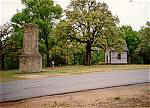
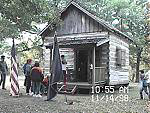 
The dramatic story of Indian fights and endless patrols, as well
as fort construction and camp life, is preserved at the Oklahoma Historical
Society's Fort Washita, located near Madill and Durant.
Directions
15 miles northwest of Durant, and 15 miles east of Madill, on SH-199.
Hours
Monday - Saturday, 9:00 a.m. to 5:00 p.m.
Sunday 1:00 p.m. to 5:00 p.m.
Closed on major State/Federal holidays.
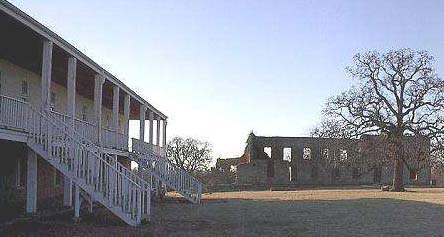
In 1841 Choctaw and Chickasaw Indians were busy building schools and
establishing law and order in southeastern Indian territory. Their prosperity,
however, was threatened by raiding plains Indians and instability on
the frontier. To intercept such raiding parties and to maintain peace,
the U.S. Army established Fort Washita.
In the late summer of 1841, General Zachary Taylor, with a small detachment
of mounted troopers, rode far into the frontier of Indian Territory,
eighty miles west of the nearest fort. His mission was to find the best
site for a new military outpost, from which soldiers could protect the
Choctaws and Chickasaws.
After thoroughly exploring the wooded region, "Old Rough and Ready"
Taylor selected a site eighteen miles north of the Red River on the
Washita River, a mile and a half east of the stream. The new fort, occupied
in April of 1842, was named Fort Washita.
Isolated even by frontier standards, soldiers moving onto the site
for construction experienced supply difficulties. Unlike most military
installations, local materials had to be used for construction and food
had to be obtained in the area. Manufactured goods from St. Louis and
New Orleans were shipped to Doaksville, located near Fort Towson eighty
miles to the east, and then moved west on the Red River to the Washita.
Construction was started by Captain George Blake using Companies A
and F of the 2nd Dragoons. Because of worn equipment and supply problems,
construction was slow. Temporary log barracks were built in 1842 and
served until the large south
barracks were built in 1850. The supply problem slowed permanent construction
and forced the troops to use temporary log structures years beyond the
normal period.
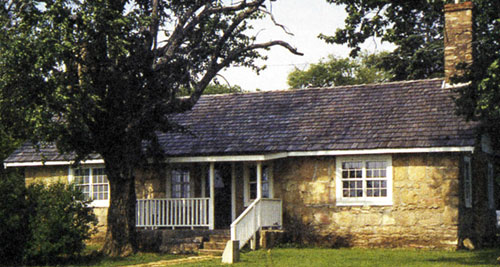
The fort served as a staging area for forays west against raiding plains
tribes. The Comanches, styled "Lords of the Southern Plains,"
proved the most consistent foes of the Washita garrison. Because the
columns operating west out of the fort were of necessity made up of
cavalry and dragoons, the fort had an extensive corral and stable area,
as well as shops for blacksmiths and farriers.
The fort ultimately covered an extensive area. The parade ground was
enclosed on the south by the South Barracks, enlisted men's quarters
now restored. On the west were the West Barracks (now in ruins), used
for enlisted men. To the north was the Commanding Officer's Quarters,
and to the east were the Bachelor's Officers' Quarters. Behind and north
of the Commanding Officer's Quarters were the Married Officers' Quarters
and the new Hospital. South of the South Barracks was the Commissary,
the old Hospital, and the Guard House.

Captain George McClellan
Many prominent men served at Fort Washita during its heyday. Among
them were General Zachary Taylor, Captains Randolph B. Marcy and George
B. McClellan, and General William G. Belknap. In 1854 Colonel Braxton
Bragg, later a Confederate general, commanded the 2nd Artillery Regiment
stationed at the fort.
Fort Washita was abandoned by federal forces in 1861, soon after the
capture of Fort Sumter in Charleston, South Carolina. Confederate forces
from Texas occupied the fort, and it became a major supply depot for
Confederate troops in Indian Territory. General Douglas Cooper commanded
the fort briefly after the Battle of Honey Springs, the largest battle
fought in Indian Territory. He is buried at the fort. General Albert
Pike served at the fort for a short period, and commanded near-by Fort
McCulloch, named for Confederate General Ben McCulloch. Stand Watie,
a Cherokee who was a Confederate brigadier general, was one of the officers
commanding the southern occupation forces. The fort was also a regional
headquarters and hospital facility for southern troops operating in
the area.
In 1870 the War Department transferred the fort to the Department of
the Interior, and it was never reactivated. Frontier expansion had overtaken
the fort and at the time of its abandonment it was militarily obsolete.
From the Department of the Interior the land was turned over to the
Chickasaw family of Abbie Davis Colbert and her son. The remaining structures
of the fort served as farm buildings well into the 20th century. The
Colbert family also utilized the cemetery as a family burial ground.
For ninety years the buildings and grounds of Fort Washita collapsed
in disrepair. Then, in 1962, Ward S. Merrick, Sr., of Ardmore, contributed
money to the Oklahoma Historical Society for the fort's purchase. Five
years later the state legislature appropriated money for restoration
which continues to this day under the guidance of the Oklahoma Historical
Society.
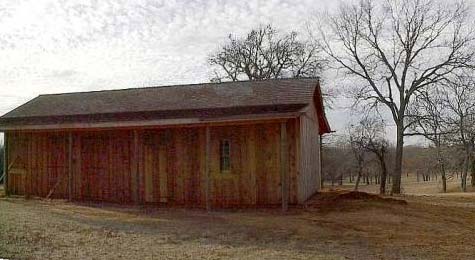
Communities and Related Links
|